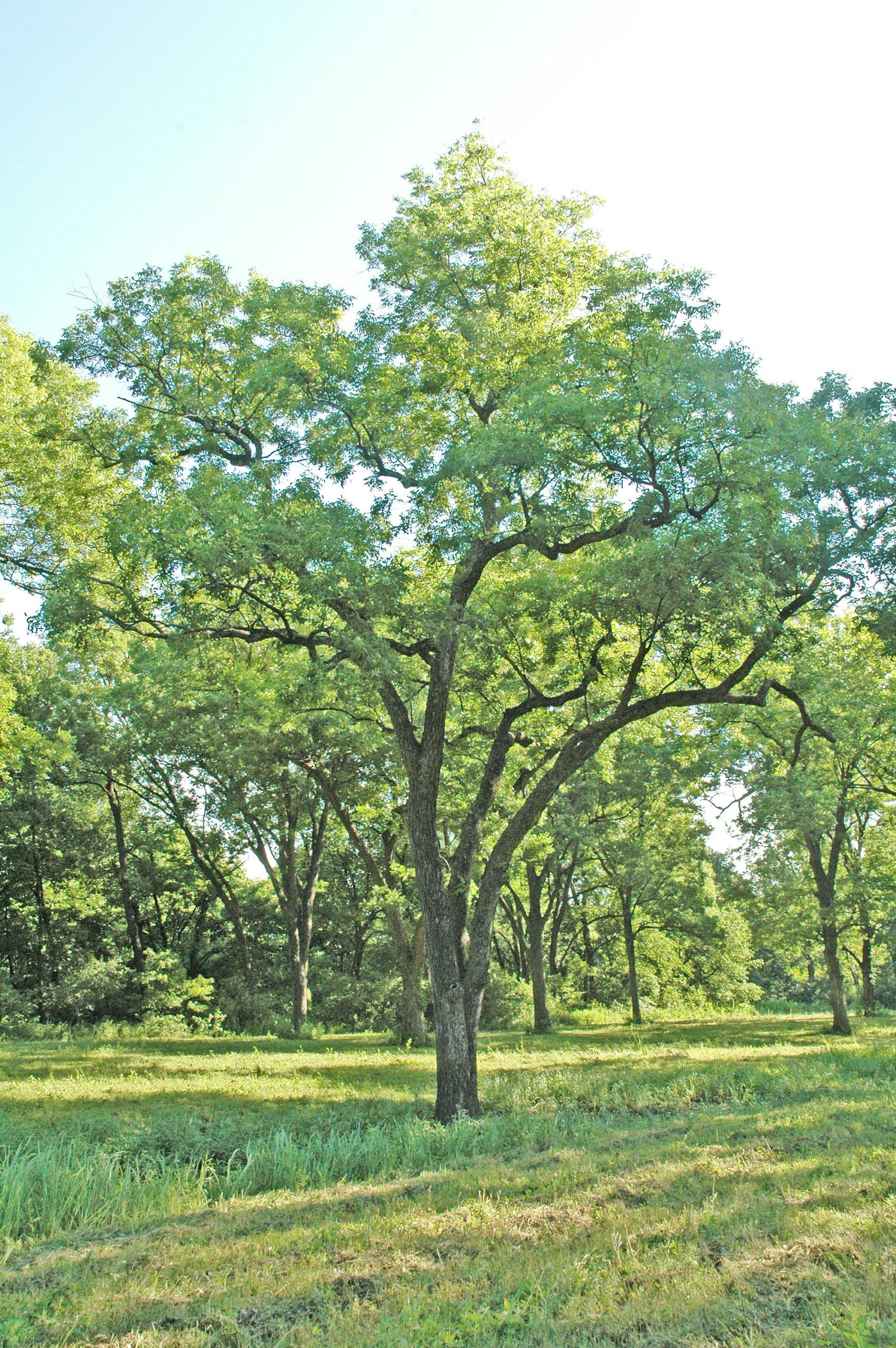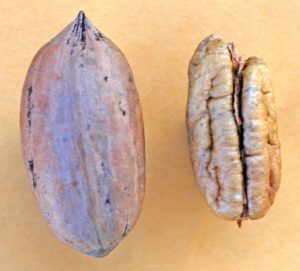The Story of a Good Native Nut

The original ‘Giles’ tree still stands in a native grove near Chetopa, Kansas. (Photo by William Reid)
Very few native pecan cultivars make it into the mainstream of the pecan industry. But I have always been fascinated by the history of native pecan cultivars that have impacted the pecan industry. The stories of the people that found outstanding native pecans and the way they became widely recognized cultivars are almost as varied as the nuts themselves. In Kansas, the most widely known native pecan cultivar is ‘Giles.’ Many pecan growers outside the northern pecan belt might not be familiar with this cultivar, but many nurseries still use ‘Giles’ seed to produce cold tolerant rootstock trees.
The cool thing about ‘Giles’ is that you can still walk up to the original tree which stands within a native grove about two miles north of my research station. The ‘Giles’ tree is located just south of the old Missouri-Pacific railroad line and two miles east of Chetopa, Kansas (Figure 1). It’s not a very impressive tree with its forked trunk and scraggly branches. However, this tree has lived through record floods, bone chilling winters, and branch breaking ice storms. Whenever I visit the original ‘Giles’ tree, I look around and try to imagine what this grove looked like nearly 100 years ago.
Fortunately for us, some of the ‘Giles’ tree history was recorded within the pages of the Annual Report of the Northern Nut Growers Association. The ‘Giles’ pecan was first described by J. Ford Wilkinson back in 1932. Wilkinson was a nurseryman from Rockport, Indiana that traveled widely across the northern pecan belt in search of outstanding nut trees. Back in the late 1920s and early 1930s, Wilkinson made several trips to Southeast Kansas to graft trees for area growers. In fact, the oldest grafted pecan grove in Kansas (currently owned by Raymond Conard of rural Chetopa) was propagated by Wilkinson.
Wilkinson made his trips to Kansas at the request of A.E. Giles of Peoria, Illinois. Mr. Giles owned a pecan grove near Chetopa that contained an outstanding seedling tree that he had named after himself—”Giles.”
Here is how Wilkinson described the Giles tree in 1932: “In three trips in as many years that I visited this tree it was bearing bountifully, while two of these were not favorable seasons and most of the tree surrounding produced only light crops. A top-worked tree of this variety in my nursery, now four years old, has produced for two seasons, a splendid crop last fall. The nut is good size, thin shell, with kernel of good quality.”
I also found Wilkerson’s description of the native pecan grove that surrounded the ‘Giles’ tree insightful: “At this place is the most beautiful natural pecan grove I have ever seen, containing more than 100 acres of pecan trees only, as all other timber has been removed and the weeds and undergrowth is kept down with a herd of 75 beautiful Angora goats.” Well, the goats are long gone, but most native groves in the area are grazed by cattle.
‘Giles’ was first widely propagated in the 1950s and became the dominant cultivar used in Kansas pecan orchards during the 1970s. Today, ‘Giles’ has been replaced in popularity among growers by scab resistant cultivars such as ‘Kanza.’
‘Giles’ nuts are easily identified in the field by an interesting characteristic not often shared by other cultivars. ‘Giles’ nuts are often crooked. In Figure 2, note that the apex of the nut points to the right. In fact, the whole right side of the nut appears shorter than the left side. Crack the nut open and you’ll find one kernel half shorter than the other.

Unlike other pecan trees, ‘Giles’ produces asymmetrical nuts, yielding kernels of different lengths. (Photo by William Reid)
Although every ‘Giles’ nut on a tree may not be “crooked”, the vast majority display this characteristic to some degree. Crooked nuts are not the result of disease or improper fertilization; asymmetrical nut development is controlled genetically. This simple quirk of nature makes ‘Giles’ one of the easiest cultivars to identify from a nut sample.
The original ‘Giles’ tree is still growing in a ditch that often holds water. The tree is also forked near the base of the tree. In my book, that’s two strikes against a native tree that would prompt a recommendation for tree removal. However, now whenever I thin trees from a native grove I make sure I’m not cutting down potentially valuable pecan germplasm. ‘Giles’ is now fading as a cultivar to graft in new orchards. As a young tree, ‘Giles’ performs beautifully. Yields are heavy and nut quality good. However, as the tree matures, problems with pecan scab, over-production, and poor kernel quality make ‘Giles’ a difficult cultivar for growers to manage profitably. “Giles’” most lasting legacy may be that it provides seed nuts for cold hardy rootstock trees.
‘Giles’ is now fading as a cultivar to graft in new orchards. As a young tree, ‘Giles’ performs beautifully. Yields are heavy and nut quality good. However, as the tree matures, problems with pecan scab, over-production, and poor kernel quality make ‘Giles’ a difficult cultivar for growers to manage profitably. “Giles'” most lasting legacy may be that it provides seed nuts for cold hardy rootstock trees.
Give fools their gold, and knaves their power; let fortune’s bubbles rise and fall; who sows a field, or trains a flower, or plants a tree, is more than all.
– John Greenleaf Whittier

